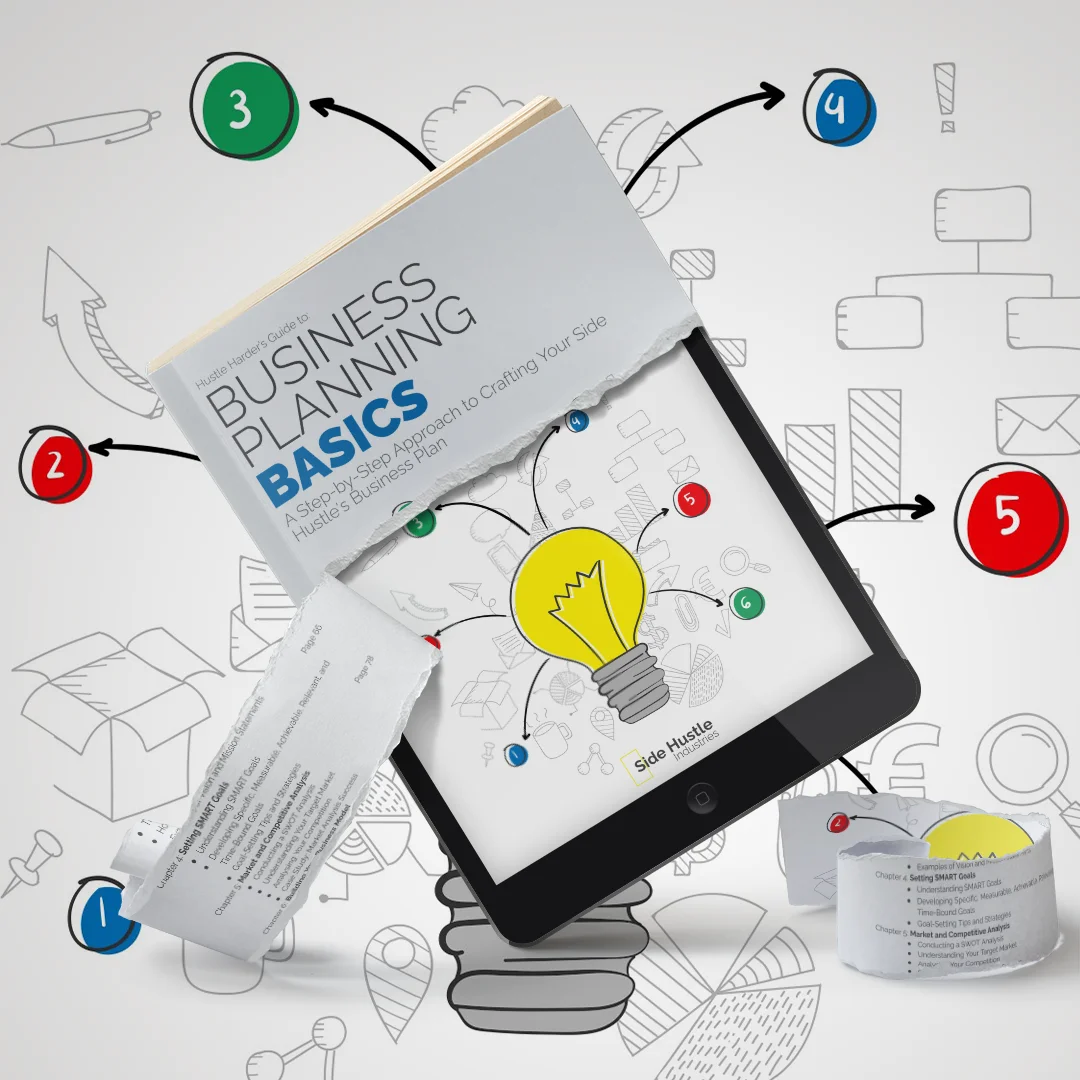
SMART Goal setting is an art that goes beyond simply creating a to-do list. When done effectively, it can propel your entrepreneurial journey forward, ensuring that you achieve your vision. In this blog, we’ll explore some tips and strategies for setting and achieving SMART goals, helping you navigate the complex landscape of entrepreneurship with focus, clarity, and motivation.
1. Start with a Vision and Mission
Before setting goals, revisit your business’s vision and mission. These core elements of your business identity should guide your goal-setting process. Your goals should align with your long-term aspirations and your business’s overall purpose. This alignment ensures that your goals are relevant and meaningful.
For example, if your side hustle’s mission is to provide affordable, eco-friendly products, your goals should reflect efforts to expand your product line, reach more customers, or enhance the sustainability of your business practices.
2. Set Clear Objectives
Define a clear and well-defined objective for each set of goals. Your objectives serve as the foundation for your goals and provide a sense of direction. When your objective is precise, it’s easier to create specific, measurable, and attainable goals that support that objective.
For instance, if your objective is to launch a new product line, you can set specific goals related to product development, marketing, and customer engagement.
3. Prioritise Your Goals
Not all goals are of equal importance, and trying to pursue too many goals simultaneously can lead to inefficiency and overwhelm. Prioritise your goals by assessing their significance and urgency. Consider which goals will have the most substantial impact on your business and focus on those first.
Use the Eisenhower Matrix, a tool that categorises tasks and goals into four quadrants based on their importance and urgency. This approach can help you determine which goals to tackle first, which to delegate, and which to set aside.

4. Break Down Goals into Smaller Steps
Breaking down larger, long-term goals into smaller, actionable steps can make them more manageable and less intimidating. This process not only provides a clear path to success but also allows you to track your progress more effectively. These smaller steps can serve as milestones on your journey toward a larger goal.
For instance, if your goal is to increase revenue by 20% in the next year, break it down into monthly revenue targets and identify the specific strategies or actions required to achieve those monthly targets.
5. Use the SMART Framework
The SMART framework is a powerful tool for goal setting. It ensures that your goals are Specific, Measurable, Achievable, Relevant, and Time-Bound. Following the SMART criteria increases the likelihood of success and provides a clear structure for your goals.
When creating SMART goals, consider how you can make each one more specific, define clear metrics for measuring success, ensure they are realistically attainable, align them with your mission and vision, and set clear deadlines for completion.
6. Monitor and Measure Progress
Regularly monitor and measure your progress toward your goals. Keep track of the key performance indicators (KPIs) and metrics that relate to each goal. This process helps you identify when you’re on track, when you need to adjust your efforts, or when you’ve achieved a goal.
For instance, if one of your goals is to increase website traffic, regularly check and analyse your website’s analytics to track the progress of your traffic growth.
7. Stay Flexible and Adapt
In the ever-evolving landscape of entrepreneurship, flexibility is crucial. Recognize that circumstances may change, and goals may need to be adjusted or realigned with your business’s evolving needs. Don’t view adjustments as failures; they are necessary to adapt to the dynamic nature of business.
Keep an open mind and be willing to pivot or modify your goals when new opportunities or challenges arise.

8. Celebrate Achievements
Acknowledge and celebrate your achievements along the way. Celebrating milestones, no matter how small, provides motivation and a sense of accomplishment. It reinforces your commitment to your goals and encourages continued progress.
Recognize the efforts of your team and reward them for their contributions to achieving goals. Celebrations can be as simple as a team lunch, a shout-out in a meeting, or a small bonus for a job well done.
9. Stay Accountable
Accountability is key to goal achievement. Share your goals with your team, mentors, or advisors who can hold you accountable for your progress. Regularly report on your progress, and seek feedback and support when needed.
Having someone to answer to can provide motivation and a sense of responsibility, increasing the likelihood of staying on track.
10. Stay Motivated
Maintaining motivation throughout your entrepreneurial journey is vital. Recognize that motivation can fluctuate, and there may be challenging periods. To stay motivated, revisit your vision and mission, visualise the successful outcome of your goals, and remind yourself of why you embarked on this journey in the first place.
Consider using vision boards, meditation, daily affirmations, or other motivation techniques to keep your energy and enthusiasm high.
11. Reflect and Learn
After achieving or recalibrating your goals, take time to reflect and learn from the process. What worked well? What could have been done differently? What did you learn from the experience? Use these insights to inform your future goal-setting strategies and continuously improve your entrepreneurial approach.
Goal setting is an ongoing process, and learning from your past goals can lead to more effective goal setting in the future.

12. Seek Feedback and Advice
Don’t hesitate to seek feedback and advice from mentors, advisors, or industry experts. They can provide valuable insights and guidance for your goal-setting process. Learning from those with more experience can help you avoid common pitfalls and make informed decisions.
Collaboration and seeking expert input can enhance your goal-setting strategy and lead to more successful outcomes.
13. Stay Persistent
Persistence is a fundamental trait of successful entrepreneurs. Even when facing setbacks or challenges, maintain your commitment to your goals. Understand that not every goal will be achieved on the first try, but perseverance can lead to eventual success.
Embrace challenges as opportunities for growth, and view setbacks as lessons that bring you closer to your goals.
14. Stay Inspired
Find sources of inspiration that resonate with your vision and mission. Surround yourself with positive influences, read books, listen to podcasts, attend conferences, and network with like-minded entrepreneurs. Inspiration can fuel your passion and drive your motivation to achieve your goals.
Remember that goal setting is a dynamic process that evolves with your business’s growth and the changing landscape of entrepreneurship. By implementing these tips and strategies, you can develop a goal-setting approach that’s both effective and adaptable, ensuring that you remain on the path to entrepreneurial success.

*Also available on Amazon in Kindle, Soft Cover & Hard Cover formats. —> Click Here.
